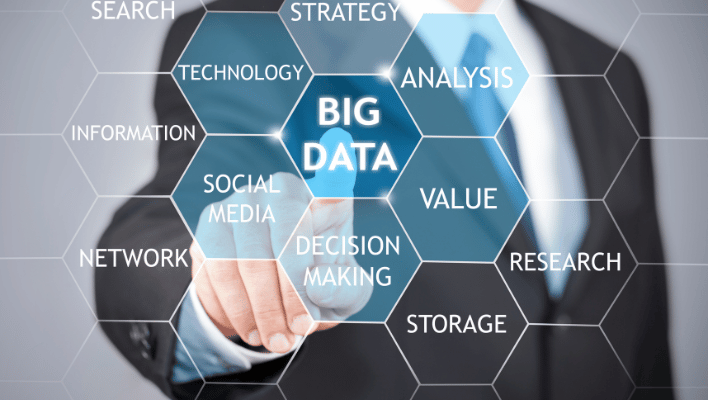Introduction
In the context of Big Data in Web 4 .0, big data plays a pivotal role in enabling the realization of its potential and advancing the intelligent web. The term “big data” refers to the massive volume of structured and unstructured data generated from various sources, including social media, Internet of Things (IoT) devices, online transactions, and more. This wealth of data provides valuable insights that can shape the future of the Internet and enhance user experiences. In this article, we will explore the significant roles that big data plays in Web 4.0, ushering in a new era of personalized and interconnected digital experiences.

Table of Contents
Web 3.0 Era: A Three-Tier Architecture
In the era of Web 3.0, technological progress will not be bound to a single innovation but rather by a cohesive integration of computing technologies known as the three-tier architecture from classic computer science: the Interface Tier, the Logic Tier, and the Data Tier.
- Interface Tier: Bridging the Digital and Physical Realms
The Interface Tier comes in two forms: Spatial and Physical. Spatial Computing occurs in a spatial environment using special peripherals like AR or VR headsets, smart glasses, and haptic devices. This allows us to interact naturally with computers in ways that align best with our biology and physiology. On the other hand, Physical Computing involves embedding computing into objects like sensors, wearables, and robotics. This enables computers to perceive and interact with the physical world, opening up opportunities for seamless interactions everywhere and even influencing the environment
- Logic Tier: The Power of Cognitive Computing
Moving to the Logic Tier, we find Cognitive Computing, which models and imitates human thought processes. This tier encompasses smart contracts, machine learning, neural networks, AI, and Quantum computing. Cognitive Computing facilitates the automation, simulation, and optimization of various activities and operations, from factory production to self-driving cars. Moreover, it acts as a valuable assistant in human decision-making processes
- Data Tier: The Strength of Distributed Computing
Finally, the Data Tier is known as Distributed Computing. It involves sharing computing power across numerous devices, such as blockchains, distributed ledgers, edge computing, and mesh computing. This approach ensures higher quality, speed, security, and trust in handling the massive amounts of data required for the Spatial Web.
Bottomline – Web 3.0: The Integrated Stack of Computing Trends
In essence, Web 3.0 incorporates Spatial (AR, VR, MR), Physical (IoT, Wearables), Cognitive (ML, AI), and Distributed (Blockchain, Edge) computing technologies, all seamlessly integrated as part of a cohesive stack. These four trends constitute the three fundamental tiers of Web 3.0.
Web 4.0: The Intelligent Web Unveiled
Background of Web 4.0: A Hypothetical Future Evolution
Web 4.0, also referred to as the “Intelligent Web,” represents the next evolutionary step in Internet development. It signifies a transition from static web pages to intelligent, dynamic, and interactive web applications, enriching the way we interact with the digital world.
Web 4.0 is envisioned to be powered by intelligent agents capable of comprehending user preferences and delivering personalized content and services. These agents will continuously adapt to changing user needs, making the web more responsive and efficient. The primary objective of Web 4.0 is to create an internet that is not only more intelligent but also more intuitive, user-friendly, and easy to navigate.
The concept of Web 4.0 is still in its conceptual phase and remains hypothetical. There is an ongoing debate among experts about its defining features and capabilities. Some envision it as an era of true artificial intelligence, where machines understand human language and interact naturally. Others perceive it as a decentralized web, leveraging blockchain technology and decentralized applications for increased user control and data ownership.
Key features of Web 4.0 encompass advanced artificial intelligence technologies such as natural language processing, machine learning, and the semantic web. These technologies enable web applications to process vast amounts of unstructured data, providing meaningful insights and personalized experiences to users based on their preferences, behaviours, and context. Additionally, the integration of the Internet of Things (IoT), cloud computing, and big data analytics allows web applications to interact with a wide range of connected devices, analyze data in real time, and deliver actionable insights and services to users.
Personalization and User Experience
The integration of big data analytics in Web 4.0 allows applications to gather and analyze vast amounts of user data, ranging from browsing habits to preferences and behaviours. By adopting a data-driven approach, web platforms can deliver highly personalized content, recommendations, and services to individual users, enhancing their overall experience. With a deep understanding of user needs and interests, Web 4.0 can create tailored interactions that cater to the specific requirements of each user, leading to higher engagement and satisfaction.
Predictive Analytics and AI Algorithms
The fusion of big data with artificial intelligence (AI) algorithms empowers Web 4.0 to accurately predict user behaviour and preferences. Through predictive analytics, historical data is leveraged to anticipate user actions, enabling intelligent agents to make informed decisions and provide proactive support. As AI continues to evolve, predictive capabilities will play a crucial role in optimizing user experiences, making the web more responsive, efficient, and anticipatory.
Business Intelligence and Decision-Making
For businesses operating in the Web 4.0 landscape, big data is a powerful tool for gaining actionable insights into customer behaviour, market trends, and product performance. Through comprehensive data analysis, businesses can make data-driven decisions, refine their strategies, and improve their products and services based on user feedback and market demands. Big data enables organizations to stay competitive by adapting swiftly to dynamic market conditions and evolving customer preferences.
Internet of Things (IoT) Integration
The proliferation of the Internet of Things (IoT) in Web 4.0 leads to the generation of an immense amount of real-time data from interconnected devices. Big data technologies manage and process this data efficiently, enabling seamless integration between physical and digital environments. By harnessing IoT-generated data, Web 4.0 applications can offer real-time, context-aware services to users, creating a more interconnected and intelligent digital ecosystem.
Enhanced Security and Fraud Detection
In the age of Web 4.0, big data analytics strengthens security measures by monitoring and analyzing network activities for potential threats and anomalies. Through sophisticated algorithms, big data can detect and mitigate cyberattacks, ensuring the protection of sensitive user information and maintaining the integrity of web applications. The constant vigilance of big data analytics helps in staying one step ahead of cybercriminals.
Optimization of Web Services
Analyzing large datasets enables Web 4.0 platforms to optimize the performance of their services. Big data-driven insights identify bottlenecks, areas for improvement, and potential optimizations, leading to faster load times, reduced latency, and overall better user experiences. By continuously optimizing web services, Web 4.0 aims to deliver seamless interactions and meet user expectations.
Sentiment Analysis and Social Media Impact
Big data plays a crucial role in sentiment analysis, enabling Web 4.0 platforms to gauge public opinions and reactions on social media and other online platforms. This analysis helps businesses and organizations understand the impact of their products, services, or campaigns on the target audience, guiding them in making data-informed decisions. Sentiment analysis assists in tailoring marketing strategies and improving brand perception.
Data-Driven Innovations
In the ever-evolving landscape of Web 4.0, big data serves as a foundation for driving innovations. The data-driven approach fosters continuous improvement and facilitates the development of new technologies and services that cater to user needs and preferences. By analyzing data patterns and user behaviour, Web 4.0 pioneers can identify opportunities for innovation and create cutting-edge solutions that enhance the digital experience.
Conclusion
The vision of Web 4.0, the Intelligent Web, presents an exciting yet challenging future. As AI, IoT, blockchain, and other advanced technologies converge, the Internet will undergo a profound transformation, providing more intelligent, personalized, and immersive experiences for users.
While the advantages of Web 4.0 are vast, stakeholders must address the potential challenges and ethical considerations to ensure its responsible and sustainable development. As we advance towards this next era of the Internet, a collaboration between governments, tech companies, researchers, and users will be crucial to shaping a Web 4.0 that benefits humanity while safeguarding privacy, security, and ethics.
In conclusion, Web 4.0 has the potential to revolutionize the way we interact with the digital world and usher in a new era of intelligence and connectivity. By addressing the challenges and responsibly harnessing the power of emerging technologies, we can pave the way for a more inclusive, efficient, and secure Internet for future generations.











